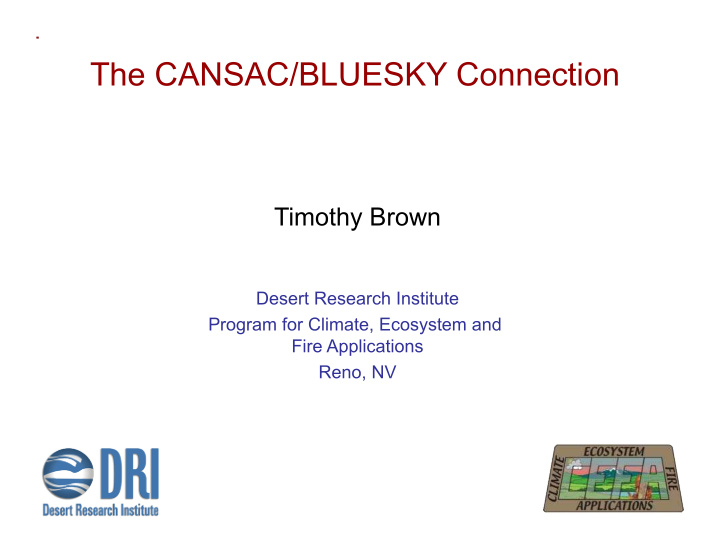



The CANSAC/BLUESKY Connection Timothy Brown Desert Research Institute Program for Climate, Ecosystem and Fire Applications Reno, NV
Partners • USDA Forest Service Region 5 • California Air Resources Board • USDA Forest Service Pacific Southwest Research Station • U.S. Fish and Wildlife Service Pacific Region • National Park Service • Bureau of Land Management California State Office • Bureau of Land Management Nevada State Office • California Department of Forestry and Fire Protection • San Joaquin Valley Air Pollution Control District • Los Angeles County Fire Department
CANSAC Structure • Board of Directors – 9 members • Operational and Applications Group – 7 members • Technical Advisory Group – 5 members
CANSAC as a Science – Decision-Maker Partnership • Partnership structure • Organizational design • Availability of resources • CANSAC management • Leadership • Progress
CEFA-CANSAC Personnel • Domagoj Podnar - Systems administration/Operations and Development Manager • Hauss Reinbold - Web and graphics • Tesfamichael Ghidey - Ph.D. student • Crystal Kolden - Outreach
MM5 Configuration Sample products • Coarsest domain 36 km, nested domain 12 km, and innermost (Nevada/California) domain 4 km horizontal grid spacing and 32 sigma (vertical) levels. • Initialized at 00Z and 12Z • Forecast length: 72 hr for domains 1 and 2, and 60 hr for domain 3
BLUESKY BACKGROUND BlueSky is a real-time smoke forecasting system that is used to predict surface smoke concentrations (PM2.5) from prescribed fire, agricultural burns, and wildfires. The BlueSky smoke forecasting system was developed by the USDA Forest Service in cooperation with the US EPA and funded by the National Fire Plan. It is currently being implemented and evaluated across the nation by the members of FCAMMS.
BlueSky Modeling Framework Fire Characteristics Meteorology Area burned CANSAC MM5 outputs Fuel moisture Winds/Temps/Moisture Fuel loadings 12 and 4 km domains Fire location 72 and 60 hour (-12 hr spin up) forecast Fire ignition time Smoke Dispersion&Transport Emissions CALPUFF/CALMET modeling system EPM emissions model PM2.5 concentrations Fuel consumption Variable rate emissions Display PM10, PM2.5,CO, CO2, CH4 PAVE visualization package NCL images (in progress) Loops and hourly concentrations of PM2.5
BlueSky Framework WEATHER FORECAST FIRE INFORMATION MODEL OUTPUT REPORTING SYSTEMS MM5 Wildfire ICS 209 WRF FUEL LOADING FASTRACS RAZU MET INTERPRETER FCCS Manual CONSUMPTION Hardy (West) Other CALMM5 NFDRS CONSUME 1.02 CONSUME 3 EMISSIONS BURNUP EPM FEPS BURNUP HYSPLIT Idealized profile TRAJECTORIES Framework is • DISPERSION Modular • CALPUFF Open-sourced HYSPLIT • Portable SMOKE TRAJECTORY & CONCENTRATION PREDICTIONS
Fire Characteristics (I) Information to derive fire characteristics is obtained from the burn reporting systems. These can be multi-agency tracking systems such as FASTRACS in the Pacific Northwest, PFIRS in California, wildfire 209 reports (NIFC), and private manually entered burn information. When the fuel loadings are not provided, the BlueSky system has three default fuel loadings look-up tables to employ: 1-km resolution fuel loadings mapping available for the western US (Hardy et al., 1998). Fuel Characteristics Classification System (FCSS) at 1-km resolution (www.fs.fed.us/pnw/fera/fccs/index.html). National Fire Danger Rating System (NFDRS) at 1-km resolution.
Emissions (I) Fuel consumption and emissions are calculated using the Emissions Production Model (EPM)/Consume v1.02 Consume is a fuel consumption model that computes the total amount of fuel consumed by a fire EPM is a model that predicts the time rate of fuel consumption and emissions from wildland biomass burns. Hourly emission rates of PM10, PM2.5, PM, CO, CO2, CH4 and heat release are obtained from this system.
Meteorology Meteorology driving the BlueSky system is obtained from MM5 forecasts A preprocessor, CALMM5, is used to extract the meteorological fields used in CALMET Horizontal and vertical winds, temps, pressure, humidity, and vapor, cloud, rain, snow, ice mixing ratios
Smoke Dispersion and Transport The BlueSky system incorporates the CALMET/CALPUFF system to predict smoke dispersion and transport CALPUFF is a multi-layer, multi-species non-steady state Lagrangian puff dispersion model which can simulate the time and space varying pollutant transport, transformation and removal CALMET is a diagnostic meteorological model that calculates the three dimensional winds and temperatures along with microphysical parameters such as surface characteristics, dispersion parameters, and mixing heights to be used by CALPUFF dispersion model
Burn Information The CANSAC BlueSky system is fed by the Wildfire 209 reports and the CANSAC web- based manual prescribed burn information system PFIRS will begin to feed data into the CANSAC system in spring 2008
BlueSky Simulations The BlueSky simulations are performed daily using the MM5 output initialized at 0Z These simulations start at midnight Surface smoke (PM2.5) concentration predictions are obtained on the nested (12 km) and innermost (4 km) MM5 domains Forecast length – 72hr: Accomplished burns are reprocessed 4-6 days back in order to account for carryover smoke
Plume Rise • Fires are currently Modeled modeled as single plumes, lofting smoke unrealistically high and lowering ground impacts Reality • In reality, fires are made of many burning areas lofting smoke to various heights 18
August - September 2005 19
SMARTFIRE satellite data feed - better location & timing (& fuels) 20
21 S. Raffuse, Sonoma Tech
Recommend
More recommend